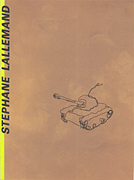 |
accès vers les télécrans / to the "magic screens |
 |
vues d'expositions |

|
textes (en français) |
Le télécran est un jouet éducatif inventé dans les années 50 par un ancien électricien qui a adapté le système de déplacement du repère de station visible derrière la vitre des anciennes radios. Ainsi, par l'action de deux boutons qui commandent deux systèmes parallèles, on obtient le déplacement du pointeur dans deux directions perpendiculaires. En frottant à la surface d'une vitre chargée de poudre métallique, le curseur enlève la poudre en rendant sa transparence à la surface vitrée donnant l'illusion d'un tracé noir. La boîte renferme hermétiquement la réserve de poudre ainsi que le système de télécommande qui entraîne le pointeur.
Ce jouet vendu à plus de 30 millions d'exemplaires de par le monde
est connu par ses utilisateurs pour sa difficulté d'utilisation. Les
télécrans, ici, sont utilisés comme un support de dessin
ordinaire. Ils sont montrés comme des tableaux. Mais ils portent un
certain nombre d'interrogations sur le lien à l'objet, sur la mémoire,
sur l'utilisation de la virtuosité comme outil, sur l'originalité
(il s'agit de reproductions d'images médiatisées) et sur la
pérennité d'une œuvre d'art, de son inscription comme marchandise,
de la circulation et de la médiatisation des images....
Quelques uns sont aujourdh'ui chez des collectionneurs privés ou dans les collections publiques (Frac Alsace, Frac Picardie, Mamco Genève). Les autres peuvent encore être acquis...
The "Télécran"
Magic Screen “Etch A Sketch” is a mechanical drawing toy which
was first manufactured in the USA by the Ohio Art Company in 1960. It was
conceived in the late 50’s by the french André Cassagnes, who
was an electrician and who got inspired from the mechanism of old radios:
indeed, their dial was composed of a graduated line which indicated the different
transmitting stations and on which we could make shift a mark from right to
left in order to chose a station, and we could do that thanks to a knob. Thus,
André Cassagnes reiterated this shifting system for the conception
of the “Télécran” : through the manipulation of
two knobs commanding two parallel systems, there is a pointer which moves
in two perpendicular directions. If we rub the inside of the surface of the
glass screen that is charged with aluminium powder, the pointer takes the
powder off the grey screen so that the surface of the glass retakes its transparency
and gives the illusion of a dark line. The box hermetically contains the stock
of powder and also the commanding system which makes the pointer moves.
More than 30 millions copies of this toy have been marketed throughout the
world and it is known by its users for being difficult to use. Here, magic
screens are used as an ordinary drawing support. They are considered as pictures.
But, in a way, they raises some questions of the connection to the object,
of the memory, of the use of virtuosity as a tool, of its originality (it
deals with reproducing pictures which have been popularized through the mass
media) and of the lasting quality of a work of art, of its registration as
a commodity, of the diffusion and media coverage of the pictures…
Some of them now belong to private collectors or to public collections such
as Frac Alsace, Frac Picardie and Mamco Genève. We can yet get the
rest of them…
Stéphane Lallemand
"télécrans" (1989 - 1992).....